
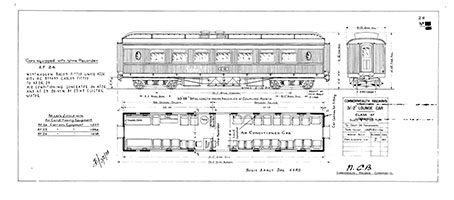
Jump to:
| AF 24 | AF 25 | AF 26 | AF 49 |
The Commonwealth Railways commenced construction of the Port Augusta to Kalgoorlie Railway in 1912. It was proposed from onset to make this a world class railway. Initially seven wooden sitting cars were purchased from Clyde Engineering Company of New South Wales. The Commissioner proposed that these cars only be used on construction trains as all steel passenger rollingstock was to be obtained for the through express. Plans were drawn up in 1915, but unfortunately due to political pressures and a world steel shortage caused by the war in europe, construction was postponed. Alternate plans were formulated for Australian built wooden cars, with each train accommodating sleeping, dining and parlor-buffet cars.
The parlor-buffet cars as proposed consisted of two compartments with loose lounge chairs and a buffet from which light refreshments could be purchased. It was initially intended that these cars should be built from the body shells of two surplus Clyde built sitting up cars, but was abandoned when it was determined that four (4) lounge cars were to be constructed in place of the proposed parlor-buffet cars.
Lounge accommodation was now provided by the building, at Port Augusta Workshops, of four (4) clerestory roofed wooden bodies which were placed on surplus flat car underframes formerly used on construction trains. Each cars was 51 feet 2 inches (15.56 metres) in length and 10 feet (3.05 metres) wide with no end platforms as had been found on all earlier purchased rollingstock. A novel feature of these cars was the lack of any side doors. Passengers could only leave the train by passing through the connecting doors into another carriage.
The cars were coded "AF" and given road numbers 24 through 27. Prior to the completion of "AF 27", the Commissioner decided the Governor General would need a special car for use during the inaugural train run on 20.10.1917, this resulted in "AF 27" temporarily being fitted out with compartments, dining room, toilets and support staff accommodation. Each lounge car cost £3530/9/5 ($7060) and was fitted with plush lounge chairs, writing desk, mirrored panels and hand coloured scenic photographs. Two compartments were provided in each car, one for women, the other for men, being divided by a wooden central partition. Shortly after entering service, these compartments were reclassified as smoking and non-smoking, rather than along traditional sexist lines.
During July 1917, another attempt was made to convince the Commissioner to purchase an all steel parlor-buffet and also a dining car from the Pullman Company of U.S.A. The Chief Mechanical Engineer intended to use these cars as prototypes for additional vehicles that would be constructed in Australia, thus overcoming the political view that it was unpatriotic to purchase all the required vehicles from overseas. The additional vehicles proposed would replace the light wooden vehicles constructed earlier as a temporary expedient when it had become obvious that steel rollingstock could not have been obtained without delaying the opening of the railway. Some of the arguments he used against the existing rollingstock included
"The type of construction, that is, steel underframes and wooden bodies has been discarded in the United States of America and Canada for a number of years and is not considered suitable for high speed service. Should an accident occur such cars are more liable to collapse than the steel bodies now used on the best trains.
The construction of the body is of such a character that they will be comparatively noisy, are partly insulated, poorly ventilated, and probably will be very dusty and drafty.
Owing to the extemporised type of car now being obtained, satisfactory vestibule connections cannot be adopted, and this factor, with special attention to dust proofing, is an essential in up to date cars."
A consequence of this report was improved wooden passenger car designs incorporating longer car bodies, roomier compartments, showers, vestibules with concertinas and turtle back (elliptical) roofs.
Complaints from passengers about ventilation and heat problems, resulted in all opening windows of lounge cars being fitted with outside louvres in 1919. Instructions issued to porters advised them that the louvres should only be lowered on the sun side of the carriage, so as to not obscure the scenic views.
After a visit by the Commissioner in 1920, two (2) pianos were hired for use in lounge cars. The first was installed on 7.4.1920. The few passengers who were upset by this innovation wrote letters to national newspapers. The Argus of 5th May 1920 had the following to say
"The Commonwealth Railway Department has added a new terror to the trials of modern travel by installing pianos in the lounge cars of the Great Western Railway. In a hotel one can escape; on a steamer there is always refuge; but for the victim of the musical enthusiast in a railway train there can be no hope. The pianos are being installed for three months just to ascertain how they stand it, but there is not a word of trying to find out how the passengers will stand it. It is just the thin end of the trombone, and is the forerunner of the jazz band with a lady conductor, who will doubtless be annoyed is she is address as the misconductor, and don"t blame her either."
But, by far the bulk of passengers were only too happy to praise the piano and condemn other railways for not providing similar diversions. The two pianos were purchased three months later.
By this time three carriage consists were in use on through express trains, preventing the removal of a lounge car for routine maintenance. Approval was granted on 15.1.1923 for construction of a new lounge car using the improved carriage styling that had previously been trialed on new sleeping cars and the special service car "SS 44". Entering service on 14.12.1923 at a cost of £5056/16/3 ($10112), the car was of a similar basic design to earlier cars but paraded more luxurious fittings. "AF 49" as the car was designated was fitted with two compartments divided by a wooden partition. Enhancements included an ornate bevelled glass door, matching light fittings, oval cathedral glass windows at either end, turtle back roof, exterior louvres, polished wooden interior and a pressed metal ceiling by Wunderlich. The leather lounge chairs were considered so comfortable that in 1925 the Victorian Railways (VR) borrowed two using them as prototypes for new chairs to be included in a refurbishment of VR parlor cars.
Stones air-conditioning was installed in "AF 49" in February 1936, making it the first car on the Commonwealth Railways to be so fitted. It provided to be so popular that all other lounge and dining cars were fitted between 1937 and 1939 as funds could be made available. It had cost £2895 to air-condition "AF 49".
Governor General"s car "AF 27" was temporarily returned to a lounge car in 1941, becoming permanent in 1946. It lacked air-conditioning, being only used as a replacement car when other lounge cars were being serviced or repaired. Ultimately placed in storage in the car barn in the early 1960's, it eventually became an office used by the carriage cleaners until being transferred to Peterborough Workshops in August 1988 for refurbishing.
See also: AFR 27 - Governor General Car
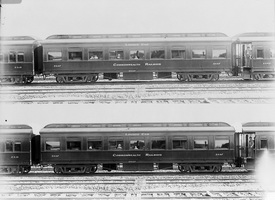
Wooden Trans-Australian Railway First class lounge car, 51 foot 2 inch in length. Built by the Port Augusta Workshops on the supplied underframe of "RA wagon 662".
| 1916 | Entered service as "RA 662" flat wagon |
| 20.10.1917 | Entered service as "AF 24" lounge car. |
| 24.11.1937 | Fitted with end stainglass windows and air conditioned, with the generator being driven by a 25HP electric motor Seats 34 passengers, weight 33T. |
| 30.6.1950 | Lounge chairs replaced. |
| 2.10.1953 | Head end power bypass cables fitted to side of car. |
| 2.12.1954 | Roller bearings fitted, radio installed. |
| 25.8.1960 | Internal alterations for tourist train, Cocktail bar installed, refrigerator and wireless placed in car. |
| 1.12.1961 | Damaged by fire at Naretha, floor repaired, new carpet fitted and wiring replaced. |
| 6.5.1968 | Air conditioning written off. It appears the car was then placed in the car barn at Port Augusta used as a general storage vehicle. |
| 3.3.1979 | Written off. |
| 2.4.1979 | Purchased by Steamtown Peterborough. |
| 1.5.1982 | Arrived at Peterborough |
| 29.5.1982 | Transferred to narrow gauge and named "Moockra". |
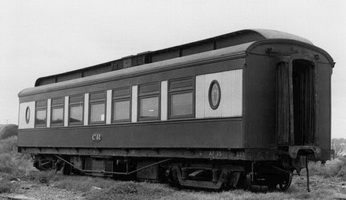
Wooden Trans-Australian Railway First class lounge car, 51 foot 2 inch in length. Built by the Port Augusta Workshops on the supplied underframe of "RA wagon 663", bogies were from No.1 Sleeping car ex Western Division.
| 1916 | Entered service as "RA 663" flat wagon |
| 24.11.1917 | Entered service as "AF 25" lounge car. |
| 3.12.1938 | Fitted with end stainglass windows and air conditioned, with the generator being driven by a 25HP electric motor Seats 34 passengers, weight 33T. |
| 21.4.1961 | Converted to narrow gauge and recoded ""NAF"". |
| 21.3.1964 | Provision for card tables, repairs to upholstery and interior woodwork. |
| 17.5.1974 | Returned to standard gauge, recoded "AF". |
| 7.11.1974 | Shelving installed to interior for use as Mobile Showroom by Provision Stores, renewed blinds, reseal and reglaze windows. |
| 3.3.1979 | Written off |
| 2.4.1979 | Purchased by Steamtown Peterborough (air conditioning removed), who renamed it "Walloway". |
| 1986 | In possession of Steamtown Peterborough, in a bad state due to weathering. Stored in the Roundhouse. |
| 2004 | Sold to South Spur Rail Services for possible use on the "Spirit of the West" Restaurant Train. |
| - | Transported by road to Western Australia. |
| 7.2005 | Move to "TAFE" college for rebuilding. |
| - | Some re-timbering done by "TAFE" college, but not completed [pr]. |
| 4.2012 | Sold by GEMCO Rail to Golden Mile Loopline Service in Boulder, Western Australia. Move to Kalgoorlie Boulder without bogies [pr]. |
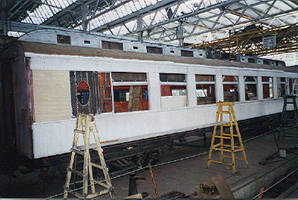
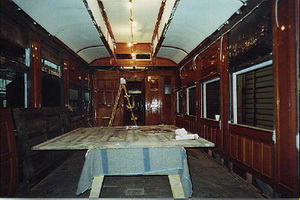
Wooden Trans-Australian Railway First class lounge car, 51 foot 2 inch in length. Built at the Port Augusta Workshops on a supplied underframe used for "RA wagon 668".
| 1916 | Entered service as "RA 668" flat wagon | ||||||||||||||||||||||||||||
| 31.10.1917 | Entered service as "AF 26" lounge car. | ||||||||||||||||||||||||||||
| 9.5.1938 | Air conditioned. Seats 34 passengers, weight 33T. | ||||||||||||||||||||||||||||
| 11.8.1961 | Interior stripped to bare wood restained and varnished, cabinet and speaker installed for amplifier equipment. Exterior burnt off and repainted. Fleurescent lighting installed, changed over from DC to head end power. | ||||||||||||||||||||||||||||
| 27.2.1970 | Light repairs and repaint. | ||||||||||||||||||||||||||||
| - | Converted for Railway Institute Model Railway Club at Port Augusta and stored in the yard. | ||||||||||||||||||||||||||||
| 1991 | Put back on rail and stored in Port Pirie car barn. | ||||||||||||||||||||||||||||
| 11.1995 | Given to ARHS Western Australia. | ||||||||||||||||||||||||||||
| 1.1996 | Transferred to W.A. | ||||||||||||||||||||||||||||
| 30.5.1997 | TIMS/WMS: shows passenger car "AF 26 Y" in AN "Mainland Division".
| ||||||||||||||||||||||||||||
| 8.7.2002 | Placed on the National Register of Historic Rail Vehicles by the National Trust | ||||||||||||||||||||||||||||
| From 2002 | Used by South Spur Rail Services on the "Spirit of the West" Restaurant Train. |
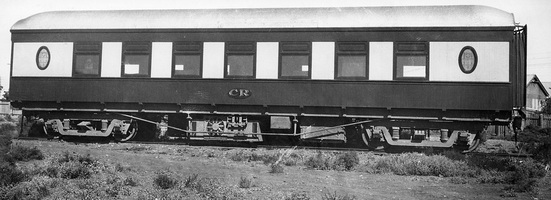
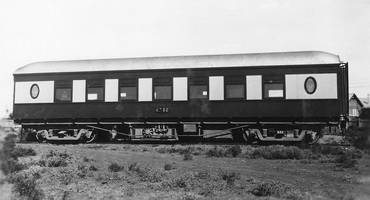
Built by the Commonwealth Railways Port Augusta Workshops, as "AF" class Trans-Australian Railway 51 foot 2 inch lounge car, with a turtle back roof. Underframe ex "RA 643" wagon. Seats 34 passengers, weight 30T.
| 4.9.1916 | Entered service as "RA 643" flat wagon |
| 1918 | Converted to "G 643" open wagon[blc] |
| 14.12.1923 | Entered service as "AF 49" lounge car. |
| 18.2.1936 | Stones air conditioning equipment fitted. |
| 14.2.1956 | Damaged by fire. |
| 4.8.1959 | Converted to narrow gauge "NAF 49" with the air conditioning removed and new drop windows. |
| 6.4.1961 | Returned to standard gauge as "AF 49". |
| 6.4.1962 | Painted internally and externally. Eventually stored in the Car barn at Port Augusta (probably in the early 1960's) being used for general storage of car cleaning items. |
| 26.5.1979 | Written off. |
| 7.6.1979 | Purchased by Steamtown Peterborough, who renamed it "Quorn". Used as part of Steamtown normal consist. |
| 3.1981 | Painted chocolate and cream. |
| 18.4.1981 | On inaugural Steamtown train. |
| 1998 | Renamed "Peterborough". |